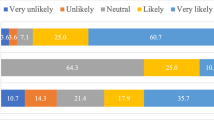Abstract
Collagenase clostridium histolyticum (CCH, Xiaflex, Xiapex) is the only FDA-approved medication for treatment of Peyronie’s disease. It is unclear how practitioners actually use CCH in their own practices. The objectives of the study were: (1) to identify variability in practice patterns for CCH among practitioners, (2) to assess adherence to the package insert instructions, and (3) to evaluate whether provider satisfaction was associated with adherence to instructions. A 30-question online survey was distributed to 1270 members of the International Society for Sexual Medicine (ISSM) from the EU, USA, Canada and Australia. Of the 30 questions, 10 survey questions had only one response consistent with the CCH package insert recommendations. An “adherence” score was calculated for each survey participant depending on how many of these questions were answered correctly. The average adherence scores of various groups were compared using a student’s t-test. A chi-squared test was used to determine association between categorical variables. Of 202 total responses, 132 practitioners reported using CCH out of 1270 ISSM members from countries where CCH is available (10.4% response rate). Practitioners from outside the USA were more likely to be satisfied with CCH (p = 0.006), and more experienced users (>20 uses) were more likely to be satisfied than less experienced users (<10 uses) (p = 0.046). Satisfied users of CCH did not have significantly different adherence scores than non-satisfied users. Even though 67% of practitioners believed they followed the package insert guidelines, only 11% adhered to all the recommendations evaluated by the survey. Treatment adherence to package insert guidelines does not appear to be associated with provider satisfaction. We believe there is utility in seeing a snapshot of these practice patterns so practitioners may feel more comfortable adapting their own practice in light of newer data supporting alternative administration methods.
This is a preview of subscription content, access via your institution
Access options
Subscribe to this journal
Receive 8 print issues and online access
$259.00 per year
only $32.38 per issue
Buy this article
- Purchase on Springer Link
- Instant access to full article PDF
Prices may be subject to local taxes which are calculated during checkout

Similar content being viewed by others
References
Ralph D, Gonzalez-Cadavid N, Milrone V, Perovic S, Sohn M, Usta M, et al. The management of Peyronie’s disease: evidence-based 2010 guidelines. J Sex Med. 2010;7:2359–74.
Nehra A, Alterowitz R, Culkin DJ, Faraday MM, Hakim LS, Heidelbaugh JJ, et al. Peyronie’s disease: AUA guideline. J Urol. 2015;194:745–53.
Gelbard M, Goldstein I, Hellstrom WJ, McMahon CG, Smith T, Tursi J, et al. Clinical efficacy, safety and tolerability of collagenase Clostridium histolyticum for the treatment of peyronie disease in 2 large double-blind, randomized, placebo controlled phase 3 studies. J Urol. 2013;190:199–207.
Highlights of Prescribing Information [Internet]. Endo Pharmaceuticals, Inc.; 2018. http://www.endo.com/File.Library/Products/Prescribing.Information/Xiaflex_prescribing_information.html. Accessed 13 Dec 2018.
Nguyen HMT, Anaissie J, DeLay KJ, Yafi FA, Sikka SC, Hellstrom WJG. Safety and efficacy of collagenase Clostridium histolyticum in the treatment of acute-phase Peyronie’s disease. J Sex Med. 2017;14:1220–5.
Hellstrom WJG, Tan RBW, Liu G. Safety profile of collagenase Clostridium histolyticum stratified by degree of penile curvature in patients with Peyronie disease. Urology. 2017;106:237 e9–237 e14.
Cocci A, Russo GI, Salonia A, Cito G, Regis F, Polloni G, et al. Predictive factors of patients’ and their partners’ sexual function improvement after collagenase Clostridium histolyticum injection for Peyronie’s disease: results from a Multi-Center Single-Arm Study. J Sex Med. 2018;15:716–21.
Abdel Raheem A, Capece M, Kalejaiye O, Abdel-Raheem T, Falcone M, Johnson M, et al. Safety and effectiveness of collagenase Clostridium histolyticum in the treatment of Peyronie’s disease using a new modified shortened protocol. BJU Int. 2017;120:717–23.
Chong W, Tan RB. Injectable therapy for Peyronie’s disease. Transl Androl Urol. 2016;5:310–7.
Gabrielson AT, Spitz JT, Hellstrom WJG. Collagenase lostridium histolyticum in the treatment of urologic disease: current and future impact. Sex Med Rev. 2018;6:143–56.
Wymer K, Zielgelmann M, Savage J, Kohler T, Trost L. Plaque calcification: an important predictor of collagenase lostridium histolyticum treatment outcomes for men with Peyronie’s disease. Urology. 2018;119:109–14.
Yafi FA, Anaissie J, Zurawin J, Sikka S, Hellstrom WJG. Results of SMSNA Survey regarding complications following intralesional injection thearpy with collagenase Clostridium histolyticum for Peyronie’s disease. J Sex Med. 2016;13:684–9.
Author information
Authors and Affiliations
Corresponding author
Ethics declarations
Conflict of interest
Dr. Ramasamy has previously received a research grant from Endo Pharmaceuticals which was unrelated to this study. Dr. Pastuszak is a consultant/speaker for Endo Pharmaceuticals. The remaining authors declare that they have no conflict of interest.
Additional information
Publisher’s note: Springer Nature remains neutral with regard to jurisdictional claims in published maps and institutional affiliations.
Supplementary information
Rights and permissions
About this article
Cite this article
Masterson, T.A., Galante, A., Butaney, M. et al. Variation in collagenase Clostridium histolyticum practice patterns: a Survey of ISSM Members. Int J Impot Res 31, 439–443 (2019). https://doi.org/10.1038/s41443-019-0126-y
Received:
Revised:
Accepted:
Published:
Issue Date:
DOI: https://doi.org/10.1038/s41443-019-0126-y



